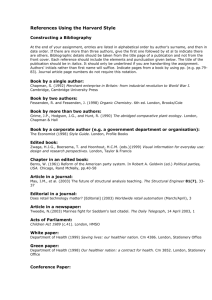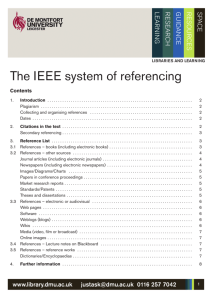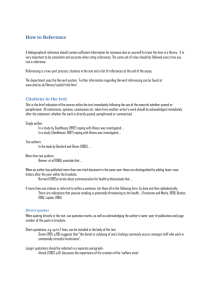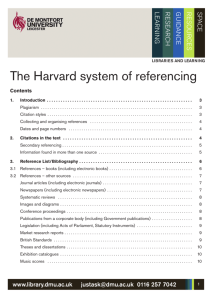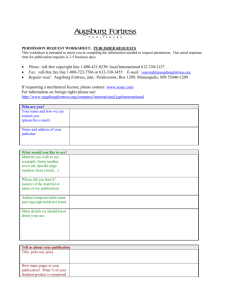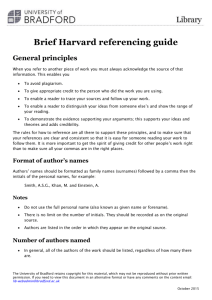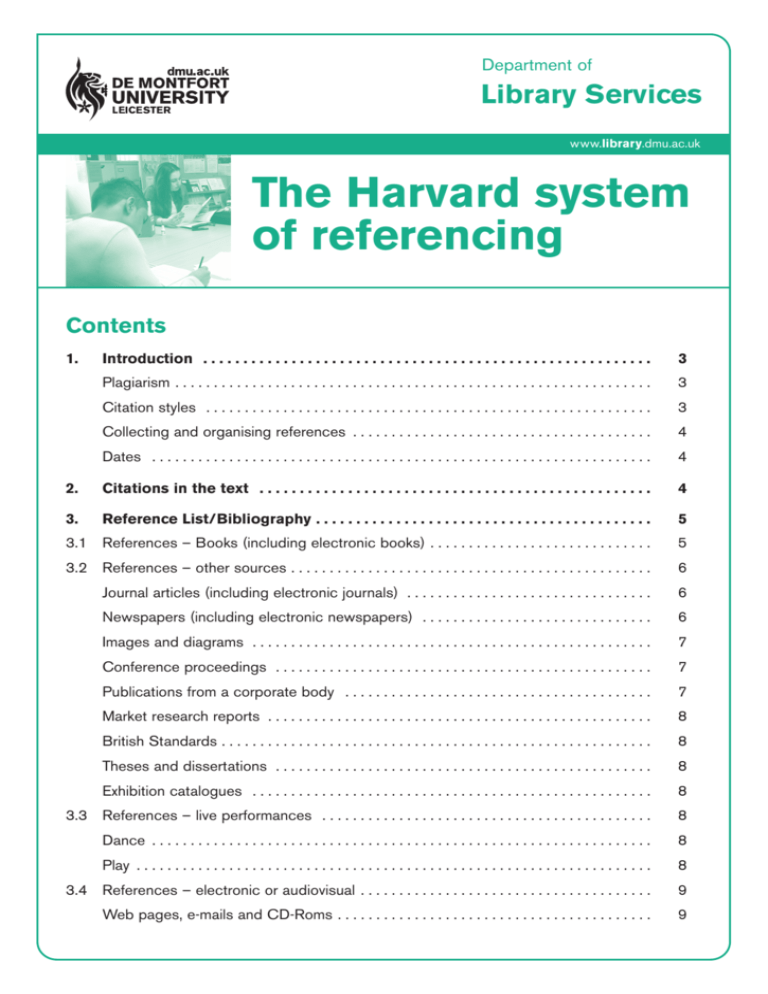
Department of
Library Services
www.library.dmu.ac.uk
The Harvard system
of referencing
Contents
1.
Introduction . . . . . . . . . . . . . . . . . . . . . . . . . . . . . . . . . . . . . . . . . . . . . . . . . . . . . . . .
3
Plagiarism . . . . . . . . . . . . . . . . . . . . . . . . . . . . . . . . . . . . . . . . . . . . . . . . . . . . . . . . . . . . . .
3
Citation styles . . . . . . . . . . . . . . . . . . . . . . . . . . . . . . . . . . . . . . . . . . . . . . . . . . . . . . . . . .
3
Collecting and organising references . . . . . . . . . . . . . . . . . . . . . . . . . . . . . . . . . . . . . . .
4
Dates . . . . . . . . . . . . . . . . . . . . . . . . . . . . . . . . . . . . . . . . . . . . . . . . . . . . . . . . . . . . . . . . .
4
2.
Citations in the text . . . . . . . . . . . . . . . . . . . . . . . . . . . . . . . . . . . . . . . . . . . . . . . . .
4
3.
Reference List/Bibliography . . . . . . . . . . . . . . . . . . . . . . . . . . . . . . . . . . . . . . . . . .
5
3.1 References – Books (including electronic books) . . . . . . . . . . . . . . . . . . . . . . . . . . . . .
5
3.2 References – other sources . . . . . . . . . . . . . . . . . . . . . . . . . . . . . . . . . . . . . . . . . . . . . . .
6
Journal articles (including electronic journals) . . . . . . . . . . . . . . . . . . . . . . . . . . . . . . . .
6
Newspapers (including electronic newspapers) . . . . . . . . . . . . . . . . . . . . . . . . . . . . . .
6
Images and diagrams . . . . . . . . . . . . . . . . . . . . . . . . . . . . . . . . . . . . . . . . . . . . . . . . . . . .
7
Conference proceedings . . . . . . . . . . . . . . . . . . . . . . . . . . . . . . . . . . . . . . . . . . . . . . . . .
7
Publications from a corporate body . . . . . . . . . . . . . . . . . . . . . . . . . . . . . . . . . . . . . . . .
7
Market research reports . . . . . . . . . . . . . . . . . . . . . . . . . . . . . . . . . . . . . . . . . . . . . . . . . .
8
British Standards . . . . . . . . . . . . . . . . . . . . . . . . . . . . . . . . . . . . . . . . . . . . . . . . . . . . . . . .
8
Theses and dissertations . . . . . . . . . . . . . . . . . . . . . . . . . . . . . . . . . . . . . . . . . . . . . . . . .
8
Exhibition catalogues . . . . . . . . . . . . . . . . . . . . . . . . . . . . . . . . . . . . . . . . . . . . . . . . . . . .
8
3.3 References – live performances . . . . . . . . . . . . . . . . . . . . . . . . . . . . . . . . . . . . . . . . . . .
8
Dance . . . . . . . . . . . . . . . . . . . . . . . . . . . . . . . . . . . . . . . . . . . . . . . . . . . . . . . . . . . . . . . . .
8
Play . . . . . . . . . . . . . . . . . . . . . . . . . . . . . . . . . . . . . . . . . . . . . . . . . . . . . . . . . . . . . . . . . . .
8
3.4 References – electronic or audiovisual . . . . . . . . . . . . . . . . . . . . . . . . . . . . . . . . . . . . . .
9
Web pages, e­mails and CD­Roms . . . . . . . . . . . . . . . . . . . . . . . . . . . . . . . . . . . . . . . . .
9
E­mails from a public domain . . . . . . . . . . . . . . . . . . . . . . . . . . . . . . . . . . . . . . . . . . . . . .
9
Weblogs (blogs) . . . . . . . . . . . . . . . . . . . . . . . . . . . . . . . . . . . . . . . . . . . . . . . . . . . . . . . .
9
Wikis . . . . . . . . . . . . . . . . . . . . . . . . . . . . . . . . . . . . . . . . . . . . . . . . . . . . . . . . . . . . . . . . . .
9
Social networking sites (Facebook, Twitter, Bebo etc) . . . . . . . . . . . . . . . . . . . . . . . . .
9
Media (video, film or broadcast) . . . . . . . . . . . . . . . . . . . . . . . . . . . . . . . . . . . . . . . . . . .
10
Online film . . . . . . . . . . . . . . . . . . . . . . . . . . . . . . . . . . . . . . . . . . . . . . . . . . . . . . . . . . . . .
10
Podcasts . . . . . . . . . . . . . . . . . . . . . . . . . . . . . . . . . . . . . . . . . . . . . . . . . . . . . . . . . . . . . .
10
Online images . . . . . . . . . . . . . . . . . . . . . . . . . . . . . . . . . . . . . . . . . . . . . . . . . . . . . . . . . .
10
3.5. References – personal communication . . . . . . . . . . . . . . . . . . . . . . . . . . . . . . . . . . . . . .
11
Lecture notes on Blackboard . . . . . . . . . . . . . . . . . . . . . . . . . . . . . . . . . . . . . . . . . . . . . .
11
3.6. References – reference works . . . . . . . . . . . . . . . . . . . . . . . . . . . . . . . . . . . . . . . . . . . . .
11
Dictionaries/Encyclopaedias . . . . . . . . . . . . . . . . . . . . . . . . . . . . . . . . . . . . . . . . . . . . . .
11
Classical works . . . . . . . . . . . . . . . . . . . . . . . . . . . . . . . . . . . . . . . . . . . . . . . . . . . . . . . . .
11
Further information . . . . . . . . . . . . . . . . . . . . . . . . . . . . . . . . . . . . . . . . . . . . . . . . .
12
4.
2
The Harvard system of referencing
This is a guide to the Harvard system but you should always check your course
handbook and/or module outline for any further guidance, as your lecturers may
prefer a different style of referencing. It is always advisable to check which system
you are expected to use and to what extent it may vary from this guide.
1. Introduction
When writing a piece of work you should provide references to the sources used. A reference
is the detailed bibliographic description of the item from which you gained your information. In
simple terms, this means the details of the items that you have used, e.g. author, title, date of
publication. References are briefly cited within the text, and then given in full at the end of your
work in a reference list. Any other items read for background information but not referred to in
the text should be given in full at the end of your work in a bibliography.
References are used to:
• Enable the reader to locate the sources you have used;
• Help support your arguments and provide your work with credibility;
• Show the scope and breadth of your research;
• Acknowledge the source of an argument or idea. Failure to do so could result in a charge of
plagiarism.
Plagiarism
Plagiarism is defined by De Montfort University Student Regulations as “The significant use by
a student of other people’s work and the submission of it as though it were his or her own”. For
more information on how to avoid plagiarism please see www.library.dmu.ac.uk/Images/Howto/
HowtoAvoidPlagiarism.pdf
Citation styles
Various citation styles exist. They convey the same information, only the presentation of that
information differs. Most style guides fall into two commonly used systems:
• author­date system (e.g. Harvard);
• numeric system (e.g. Vancouver, MLA).
Whichever system you use, it is important that you are consistent in its application.
This guide is intended to provide you with advice on how to use the Harvard (author­date)
system where you supply the author’s name and the date of publication of the document
referred to within the text. In order to find out more about the document a reader can simply
look up the author’s name in the reference list.
3
Collecting and organising references
It is often not easy (or possible) to retrieve sources after you have written your text. For this
reason it is best to keep a good record of everything that you use. Bibliographic software, such
as EndNote, Procite or Reference Manager, will help you organise your references according to
different citation systems and to add the citations to your text. Alternatively, you could store your
references on index cards. For further information and help using EndNote please refer to the
guide at: www.library.dmu.ac.uk/Images/Selfstudy/Endnote.pdf.
A note about dates
If no date can be established you can use n.d. e.g. Webb (n.d.)
If the date can be established but only approximately you should use Webb (c.2001)
2. Citations in the text
All ideas taken from another source regardless of whether directly quoted or paraphrased need
to be referenced in the text of your assignment. To link the information you use in your text to its
source (book, article, etc.), put the author’s name and the year of publication at the appropriate
point in your text. If the author’s name does not naturally occur in your writing, put the author’s
surname and date in brackets.
So if the author’s name is James Robert Jones, you would use the surname Jones and the date
to cite in the text.
e.g. There is some evidence (Jones, 1992) that these figures are incorrect.
If the author’s name is part of the statement, put only the year in brackets:
e.g. Jones (1992) has provided evidence that these figures are incorrect.
If there are two authors, give both:
e.g. It is claimed that government in the information age will “work better and cost less”
(Bellamy and Taylor 1998, p.41).
Note: if you are giving a direct quotation then you need to include the page number.
If there are more than two authors, cite only the first followed by ‘et al.’ (which means ‘and
others’):
e.g. …adoptive parents were coping better with the physical demands of parenthood
and found family life more enjoyable (Levy et al. 1991).
Note: up to three author names can be given in your reference list/bibliography.
If an author has published more documents in the same year, distinguish between them by
adding lower­case letters:
e.g. In recent studies by Smith (1999a, 1999b, 1999c)…
4
If you wish to cite a work described in another work
When an author quotes or cites another author and you wish to cite the original author you
should first try to trace the original item. However, if this is not possible, you must acknowledge
both sources in the text, but only include the item you actually read in your reference list.
e.g. If Jones discusses the work of Smith you could use:
Smith (2005) as cited by Jones (2008)
or Smith’s 2005 study (cited in Jones 2008, p.156) shows that…
Then cite Jones in full in your reference list.
Citing web resources in the text use
Author, but if not available then use
the organisation as the author.
Title of site, only use if there is no author or organisation.
If there is no author, organisation or title, use truncated web address (You should question if
this resource is suitable for academic work).
Information found in more than one source
If you find information in more than one source, you may want to include all the references to
strengthen your argument. In which case, cite all sources in the same brackets, placing them in
order of publication date (earliest first). Separate the references using a semi­colon (;).
e.g. Several writers (Jones 2004; Biggs 2006; Smith 2008) argue…
3. Reference List/Bibliography
Full references of sources used should be listed at the end of your work as a reference list. This
list of references is arranged alphabetically usually by author. You may also be required by your
tutor to include a bibliography which should list all items used within the text but also include
any other sources you have read as part of your research.
Whenever possible, elements of a bibliographical reference should be taken from the title page
of the publication. Each reference should give the elements and punctuation as found below.
Authors should always be in capitals.
If the author is James Robert Jones this will become JONES, J.R. Abdul­Rahman Al­Haddad
would be AL­HADDAD, A.
The date in brackets after the author. In these examples, the source (e.g. title) has been
italicised; you can also emphasise the source by underlining or typing in bold. It does not
usually matter which you use, so long as you are consistent throughout your reference list.
3.1. References – Books
Books
AUTHOR(S) (Year) Title. Edition – if not the 1st. Place of publication: Publisher.
e.g. KADOLPH, S.J. (2007) Textiles. 10th ed. New Jersey: Pearson Prentice Hall.
5
Books with two or three authors
e.g. LI, X. and CRANE, N.B. (1993) Electronic style: a guide to citing electronic
information. London: Meckler.
Books with more than three authors – give the name of the first author, followed by ‘et al.’
(and others).
e.g. LEVITT, R. et al. (1999) The reorganised National Health Service. 6th ed.
Cheltenham: Stanley Thornes.
Books with one or more editor(s) – Include the abbreviation (ed.) or (eds.) after their surname.
EDITOR(S) (ed./eds.) – (Year) Title. Edition. Place of Publication: Publisher
e.g. KEARNEY, R. and RAMUSSEN, D. (eds.) (2001) Continental Aesthetics –
Romanticism to Postmodernism: An Anthology. Oxford: Blackwell Publishers Ltd.
Chapters in books
AUTHOR(S) (Year) Title of chapter. In: AUTHOR(S)/EDITOR(S), ed(s). Book title. Edition.
Place of publication: Publisher, Pages. (use p. or pp.)
e.g. TUCKMAN, A. (1999) Labour, skills and training. In: LEVITT, R. et al, (eds.)
The reorganised National Health Service. 6th ed. Cheltenham: Stanley Thornes,
pp. 135­155.
Note: Electronic books should be cited exactly the same as print, following the rules above.
3.2. References – other sources
Journal articles
AUTHOR(S) (Year) Title of article. Title of journal, Vol. no. (Part no./Issue/Month), Pages,
use p. or pp.
e.g. LU, H. and MIETHE, T.D. (2002) Legal representation and criminal processing in
China. British Journal of Criminology, 42 (2), pp. 267­280.
Note: If you are referencing an electronic journal article, use the standard referencing format.
e.g. DREXHAGE, J. (2004) Still up in the air. Carbon finance, (January), pp. 16­17.
Newspaper articles
AUTHOR(S) (Year) Article title. Newspaper title, Day and Month (abbreviated), Pages, use
p. or pp.
e.g. BROWN, P. (2002) New foot and mouth outbreak suspected. Guardian, 27th Feb,
p. 1.
Newspaper articles taken from the Internet or a database should be cited as print using the
rules above.
6
Image(s) or Diagram(s) within a book
Where the image cited from a book is not the work of the author, additional reference to the
work should be made, as follows:
Image:
ARTIST (Year). Title of the work [Material types]. At or In: (where found, for example in a book
or museum). IN: AUTHOR/EDITOR of book. (Year). Title. Place of publication: Publisher.
e.g. MASOLINO, T. (1427) The Temptation of Adam and Eve [Painting]. In: BRUCE­
MITFORD, M. (1996). The Illustrated Book of Signs and Symbols. London: Dorling
Kindersley.
or
Diagram:
MINTZBERG, H. (1979) The basic parts of organisations — Mintzberg’s model
[Diagram]. In: COLE, G.A. (2004). Management Theory and Practice. 6th ed. London:
Thomson.
Papers in conference proceedings
AUTHOR(S) (Year) Title. In: EDITOR(S) Title of conference proceedings. Place and date of
conference (unless included in title). Place of publication: Publisher, Pages, use p. or pp.
e.g. GIBSON, E.J. (1977) The performance concept in building. In: Proceedings of the
7th CIB Triennial Congress, Edinburgh, September 1977. London: Construction
Research International, pp. 129­136.
Publications from a corporate body (e.g. Government publications)
NAME OF ISSUING BODY (Year) Title. Place of publication: Publisher, Report no. (where
relevant), Pages, use p. or pp.
Please note that where the author is a government body, the country becomes the author. If an
official report has individual authors these should not be used, instead use the official body.
e.g. GREAT BRITAIN. DEPARTMENT OF THE ENVIRONMENT, DEVELOPMENT
COMMISSION (1980) 38th Report, 1st April 1979 to 31st March 1980. London:
HMSO, 1979­80 HC. 798, pp. 70­81.
For reports known by the name of the chairman or person responsible for the inquiry, include a
see reference in your reference list, in addition to the main entry.
e.g. Cadbury report — see — COMMITTEE ON THE FINANCIAL ASPECTS OF
CORPORATE GOVERNANCE (1992).
COMMITTEE ON THE FINANCIAL ASPECTS OF CORPORATE GOVERNANCE
(1992) Report of the Committee on the Financial Aspects of Corporate Governance
(Cadbury Report). London: Gee
For reports known by their title rather than their author/s, include a see reference in your
reference list, in addition to the main entry.
7
e.g. The Cleveland Enquiry – see GREAT BRITAIN. DEPARTMENT OF HEALTH AND
SOCIAL SECURITY (1988).
GREAT BRITAIN. DEPARTMENT OF HEALTH AND SOCIAL SECURITY (1988)
Report of the enquiry into child abuse in Cleveland. London: HMSO, Cm 413.
Market research reports
NAME OF ISSUING BODY (Year) Title, date if available. Edition (if available) Place of
publication: Publisher, Report no. (if relevant)
e.g. MINTEL (2008) Coffee: Mintel marketing report. January 2008. London: Mintel International.
or KEY NOTE (2007) Confectionery: Key Note market report. 25th ed. Hampton: Key Note.
British Standards
NAME OF AUTHORISING ORGANISATION (Year of publication) Number and title of
standard. Place of publication: Publisher.
e.g. BRITISH STANDARDS INSTITUTE (2008) BS ISO 8178­2: Reciprocating internal
combustion engines – Exhaust emission measurement. London: British Standards
Institute.
Theses and dissertations
AUTHOR (Year) Title. Designation (Level, e.g. MSc, PhD.), Institution.
e.g. MARSHALL, J. (2002) The Manuscript tradition of Brunetto Latini’s “Tresor”.
Unpublished thesis (PhD), University of London.
Exhibition catalogues
ARTIST (Year) Title of exhibition. [Exhibition catalogue]. Place of publication: Publisher.
e.g. HARRIS, W. (1983) William Harris as designer. [Catalogue of an exhibition held at
the Whitworth Art Gallery, 3 May – 4 June 1983]. London: Arts Council.
3.3. References – Live Performance
Dance
COMPOSER or CHOREOGRAPHER (Year of premiere) Title. Company (optional). [Location.
Date seen].
e.g. ASHTON, F. (1948) Cinderella. [Royal Opera House, London. 13th January 2004].
Play
Title by Author (Year of performance) Directed by. Company (optional). [Location. Date seen].
e.g. An Inspector Calls by J.B. Priestley (2009) Directed by STEPHEN DALDRY.
[Arts Theatre, Cambridge. 11th May].
Always follow the guidelines in your student/programme handbook.
8
3.4. References – Electronic or audiovisual
Web Pages, e­mails and CD­Roms
Electronic references should contain the following elements:
AUTHOR(S) (Year) Title of document [Type of resource, e.g. CD­ROM, e­mail, WWW]
Organisation responsible (optional). Available from: web address [Date accessed].
e.g. UNIVERSITY OF SHEFFIELD LIBRARY (2001) Citing electronic sources of
information [WWW] University of Sheffield. Available from:
http://www.shef.ac.uk/library/libdocs/hsl­dvc1.pdf [Accessed 23/02/07].
If you are referencing an electronic journal article, newspaper article or book, use the
standard referencing format for that item. Guidelines can be found above.
Note: Dates are not always available for web pages, if this is the case use (n.d.) where n.d.
represents no date so that the reader knows you have omitted this element.
e.g. HOME HEALTH UK (n.d.) Thyroid problems [WWW] Home Health UK.
Available from: http://www.homehealth­uk.com/medical/thyroidproblems.htm
[Accessed 10/12/07].
E­mail message from a public domain. e.g. discussion boards or conferences.
AUTHOR (of message) (Year) ‘Subject of the message’ [Online] Electronic conference or
bulletin board. Date Posted: day/month of posting. Available from: email address.
e.g. BROWN, F. (2007) ‘How to promote online reading’ [Online] Library and
information professionals discussion list: 12th May. Available from:
http://www.jiscmail.ac.uk/lists/LIS­profession.html.
Weblogs (Blogs)
AUTHOR. (Year) Title of the posting (if applicable). Title of the site. Weblog [Online] day/month
of posting. Available from: web address. [Accessed date].
e.g. TRANSPORTATION SECURITY ADMINISTRATION (2008) Behaviour detection
officers lead to arrest in Orlando. Evolution of security. Weblog [Online] 2nd April.
Available from: http://www.tsa.gov/blog/. [Accessed 03/04/08].
Wiki
WIKI NAME. (Year) Title of article. [Online]. Available from: web address. [Accessed date].
e.g. INFOTEACH (2007) Learning_outcomes. [Online]. Available from:
http://infoteach.org/wiki/doku.php/learning_outcomes. [Accessed 18/04/08].
Social networking sites (Facebook, Twitter, Bebo etc)
These are web pages so will be referenced as such.
AUTHOR(S) (Year) Title of page. [Title of web site] Day/month of posted message. Available
from: web address. [Date accessed].
e.g. JONES, S. (2009) Referencing Group. [Facebook] 5th May. Available from:
www.facebook.com. [Accessed 09/05/09].
9
Media (video, film, or broadcast)
Title (Year) Type of media. ORIGINATOR (e.g. director). Place of production: Production company.
e.g. Rebel without a cause (1983) Film. Directed by NICHOLAS RAY. USA: Warner Bros.
A television or radio broadcast should also include the date and time of broadcast and the
episode number, where possible.
Title (Year) Type of media. ORIGINATOR (e.g. channel). Exact date and time of broadcast.
e.g. Dyslexic children (1999) TV. CHANNEL 4. 29th July, 1900 hrs.
or Doctor Who (2008) Episode 8, Silence in the library. TV. BBC1. 31st May, 1900 hrs.
or Book of the week (2008) The Atlantic Ocean. Radio. BBC RADIO 4. 21st July,
0945 hrs.
Individual contributors or interviewees should be cited as follows:
e.g. BROWN, G. (2008) Interview. In: Today Programme. Radio. BBC RADIO 4.
15th May, 0810 hrs.
Online Film
SCREEN NAME. (Year). Title of film [type of resource]. Available from: web address [Date
accessed].
e.g. LOSANGELESOPERA. (2008). Tristan und Isolde podcast [online video]. Available
from: http://www.youtube.com/watch?v=SgqqxAiISRw [Accessed 03/04/08].
Podcasts
BROADCASTER (if available). (year) Name of podcast [type of resource e.g. podcast].
Organisation/publisher responsible (optional), day of podcast (day, month) Available from:
web address [date accessed].
e.g. HOPKIN, K. (2008) The mythical daily water requirement [podcast]. Scientific
American, 2nd April. Available from: http://www.sciam.com/podcast/episode.cfm?
id=0BD1CF72­E411­2EE5­A4CDEE3447E81C93 [Accessed 03/04/08].
Online images
ORIGINATOR (Year) Description or title of image [Online image]. Available from: web address.
[Date accessed].
e.g. SCIENCEBLOGS (2006) Polar Bear [Online image] Available from:
http://scienceblogs.com/strangerfruit/polar­bear.jpg [Accessed 15/06/09].
10
3.5. References — Personal Communication
A personal communication can be a letter, memo, email, fax, an interview, an informal
conversation, telephone call or a lecture presentation. They should be included within the text
but not generally in the reference list as the reference is not traceable.
When referencing a personal communication you should:
• Ask permission of the person before quoting them
• Provide the communicator’s initials and surname and the type of communication in the text
• Provide the exact date of the communication
e.g. In an email on 23rd July 2007 J. Brown stated that…
or In a conversation on 25th March 2008 B. Jones confirmed that…
or In a lecture on 8th January 2008 V. Rolfe outlined…
Lecture notes on Blackboard
NAME. (Year of presentation). Lecture title, from module code (capitalised) title of module.
Teaching organisation, location and date of presentation. Available from: Blackboard [Accessed
date].
e.g. POULTON, A. (2008). Referencing and citation – Harvard style, from BIOM2060
Professional Skills 2. De Montfort University, Kimberlin Library on 6th November.
Available from: Blackboard. [Accessed 29/07/08].
3.6. References – Reference Works
Dictionaries/Encyclopaedias
If an encyclopaedia entry has a named author then the format for a chapter in a book should be
used with the addition of the encyclopaedia volume number.
AUTHOR(S) (Year) Title of chapter. In: AUTHOR(S)/EDITOR(S) ed(s). Title, Volume (if
applicable), Edition. Place of publication: Publisher, Pages. (use p. or pp.)
e.g. KESNER, R.P. (2002). Memory neurobiology. In: RAMACHANDRAN, V.S.
Encyclopedia of the human brain, Vol. 2. San Diego: Academic Press, pp. 783­796.
If there is no author then the title (e.g. Oxford English Dictionary) should be used both within the
text and in the reference list.
Title. (Year) Volume (if applicable), Edition. Place of publication: Publisher.
e.g. The Oxford English Dictionary (1989) Vol. 3, Oxford: Clarendon Press.
Classical Works
Principal classical works such as the Bible and Koran/Qur’an should only be included in the text and
not in the reference list. Appropriate details should be included but no year should be included.
e.g. ‘Remain in me, and I will remain in you. No branch can bear fruit by itself’
(John 15:4, New International Version).
11
4. Further Information
If you need further help please contact your subject librarian or email justask@dmu.ac.uk.
Alternatively further guidance on citation and referencing can be obtained from the following
online sources. Remember, it is always advisable to consult the person for whom you are
writing, whether it is a tutor or an editor, as to which style of referencing they want you
to use.
HARNACK, A. and KLEPPINGER, E. (2003) Online! A reference guide to using internet
sources [WWW]. St Martin’s. Available from: http://www.bedfordstmartins.com/online/
index.html [Accessed 31/05/09].
HOLLAND, M. (2006) BU guide to citation in the Harvard style. [WWW]. Bournemouth
University. Available from: http://www.bournemouth.ac.uk/library/citing_references/docs/
Citing_Refs.pdf [Accessed 31/05/09].
UNIVERSITY OF BIRMINGHAM (2006) Referencing [WWW]. University of Birmingham,
Information Services. Available from: http://www.i­cite.bham.ac.uk/referencing.shtml
[Accessed 31/05/09].
UNIVERSITY OF THE WEST OF ENGLAND (2009) A guide to references [WWW].
University of the West of England, Library Services. Available from: http://www.uwe.ac.uk/
library/resources/general/info_study_skills/refs.htm [Accessed 31/05/09].
This guide is also available on the library web site at:
www.library.dmu.ac.uk/Images/Selfstudy/Harvard.pdf
www.library.dmu.ac.uk
Available in large print and screen .pdf. Publication No 23056.
© De Montfort University, September 2009 (PC1989). Right of revision; this leaflet is issued without prejudice to the right of the University
authorities to make such modifications to the matter dealt with as the University authorities consider necessary without prior notice.


